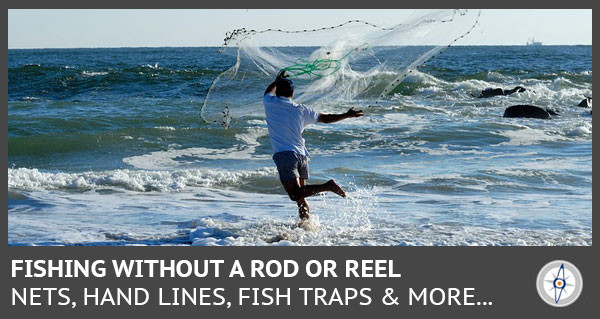SDN has moved!
Subscribe to our new @SurvivalDispatchNews Youtube channel
When you find yourself in a survival scenario, there are several priorities on which you need to focus. We call these the four pillars of survival. They are food, water, fire, and shelter.
The reason for these points of focus is that humans can die from exposure in as little as three hours without shelter or fire. They can die from dehydration within three days without water. They can die within three weeks without food. This makes these items critical if you want to survive.
Why Is Food so Important?
If you can make it three weeks without food and most survival scenarios are over within a week or two, why is food so important? The answer is that food does more than just keep our bodies alive. As you go long periods of time without food, the body starts to eat itself.
It starts by consuming your fat reserves for energy to keep going. Then it moves on to the muscle tissue which can start to really make you weak and clumsy. It can make required survival tasks hard to complete, and can make you more prone to injury.
The real issues come into play as the body starts to consume organ tissue including brain tissue. This can make a you incredibly sick. You are in pain all the time, and start becoming very confused. Memory loss is quite common, and a deep depression sets in. In survival scenarios, this can make it difficult to have the necessary motivation to continue pushing on. Without this motivation, you may not collect the water or fire wood that you need for short term survival.
Why Protein and Why Fish?
By far the easiest way to collect food in the wild is collecting wild edibles. With some basic knowledge of plant identification, you can spend just a few minutes and have enough plants to fill your belly. The problem is that the number of calories is limited, and there is very little protein found in wild edibles.
You can spend your time and energy hunting or trapping, but the odds of success are slim and you expend a great number of calories. Fishing is often the easiest way to find protein in the wild without expending a great number of calories. Fish are full of fats, healthy oils, calories, and protein to keep you alive and functional.
Most of us are used to fishing with a rod and reel. Unfortunately, the only time you will have this with you during a survival scenario is if you get lost on a fishing trip.
Do not be discouraged.
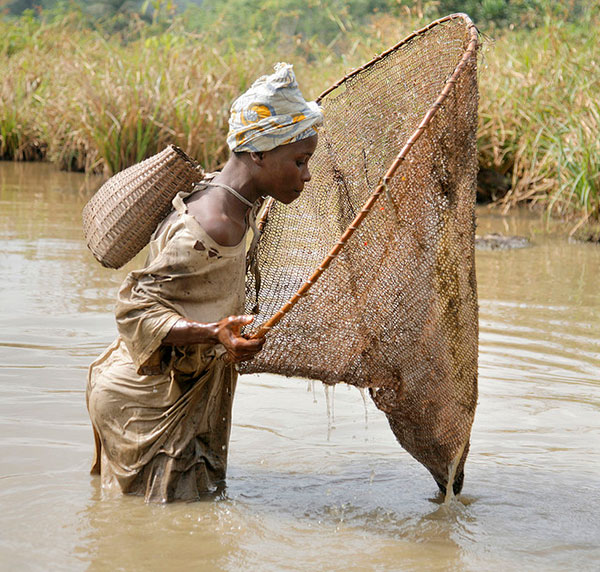
Fishing with a hand net in Liberia (via Pinterest)
Most of the world does their fishing without modern rods and reels.
Many methods for fishing without a modern setup are more efficient than the alternative. Primitive fishing methods often let you set up your rig and leave it there all day while you complete other tasks or rest. In addition, many of these methods allow you to catch several fish at a time.
Nets
Nets have been used for thousands of years to catch fish from the land and from boats. They allow you to catch several fish at once, and can be used for passive fishing or for active fishing. The only downside is that they do not allow you to distinguish between fish species. But when you are trying to survive, the species of fish does not matter.
Gill Nets
Gill nets are vertical nets designed to trap fish as they attempt to swim through an area of water. You can use large ones as long as 50 feet or small ones as short as 15 feet. I always keep one in my bug out bag because I have caught multiple fish every time I have used one.
Preferably, you want to attach floats to the top and weights to the bottom to keep it vertical. Then attach each end to a post, tree, or other secure object. These work best in streams, rivers, or tidal areas because of the moving water. However, I have had luck in still water as well.
Throw Nets
Throw nets are circular nets with weights around the edges and a draw line attached to the center. These require some practice, but to throw it you bundle it up with the weights at one end and the line at the other. You place it over your shoulder and rotate like you are throwing a shot put to fling it weights first as far as you can.
The deeper the water where you throw it, the better. Let it sink to the bottom, and then draw in the line to scoop up your fish. You will need to get chest deep in water, so be ready to dry off if needed.
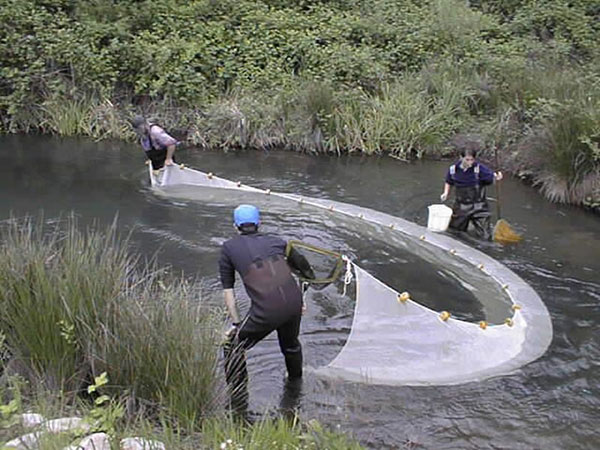
Seine nets are similar to gill nets in that they are vertical, but much smaller. They are typically held by two people with the net dragged in between as they wade through the water. You should have the bottom just above the rocks and the top as high as possible.
As you drag the net, you should work your way to the shore to trap any fish. The only downside to this is that you need two people and you are going to get wet.
Hand Lines and Cane Poles
These two methods of fishing are the closest versions to a modern rod and reel. For hand lining, you will need a line, hook, and bait. Ideally you also want a spool for your line such as a bottle or smooth stick. Wrap your line around the spool, place the spool in your left hand, and the last few feet of line in your right.
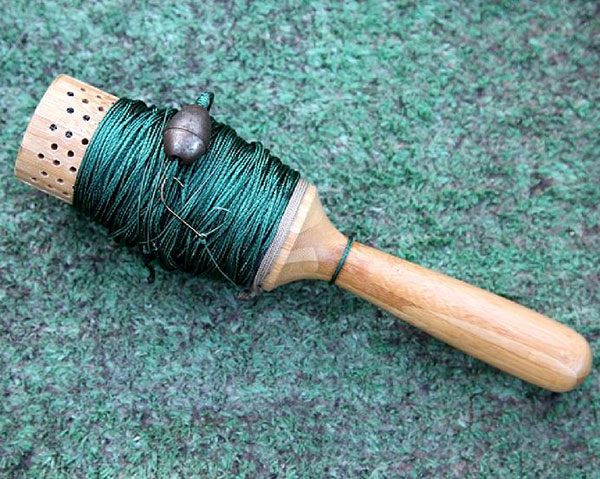
Your baited hook needs to be heavy to get distance, so either use heavy bait or attach a weight. Start swinging the line around and around underhanded and release it when it is moving up and out. Hold out your left arm to let the line fly off the spool. Then draw in your line with or without a fish by wrapping it back around the spool. This will keep it from getting tangled.
Cane poles are designed to hold a line out far from the shore when standing on a high point. Find a long and skinny pole. Bamboo or other canes are ideal for this. Make it at least 10 feet long. Attach a line that is about 20 feet long with a heavy baited hook. Get on a high point above the water like a rock outcropping.
Throw out the bait with your right hand and then fling the line backhanded with the pole in your left hand. This should get the line out about 20 feet from the rock. You can bounce it along the bottom or hold it closer to the top. When you are ready to bring it in, you will need to reel in some of the line with your hand before pulling it in with the pole.
Trot Lines and Jug Lines
These methods of fishing allow you to set up the rig and come back for the fish later. For a trot line, you are running a primary line and attaching dozens of additional hook lines to it. For this you should have a primary line between 30 and 50 feet long. Tie a loop in the line every three feet and attach one end to a tree with another to a heavy weight.
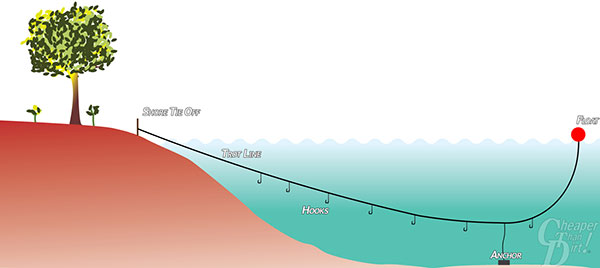
Trot Line (via cheaperthandirt.com)
Then run a two to three foot line with a baited hook from each of the loops. Cast out the weighted end as far as possible. This gives you baited hooks at several depths and several locations within the water.
Jug lines are essentially large floats with heavy baited hooks. If you are not in a boat, you need to make sure the weight will take it to the bottom and the line is long enough to reach the bottom. The float is typically a large, sealed plastic bottle. You can cast several of these out into an area and wait for the float to start moving. You can either wade or swim to your float, or you can attach a draw line to it to bring it in with your fish.
Bank Poles and Branch Lines
These methods are both designed primarily for bottom feeders such as catfish. You will want a heavy weight tied about three feet above a baited hook. It should be attached to a long pole and shoved into the mud alongside the bank. Use the same method as hand lining to fling the baited hook into deep water. Pull it in by hand when a fish strikes. You can also use low hanging branches from trees on the shore to accomplish the same thing. You normally want five to ten lines in the water, and it works best at night.
Fish Traps
There are many ways to make fish traps so you can come back later and collect your fish. One of the oldest methods is the heart shaped trap. You will need either many wooden poles or many stones. In a shallow pool of water you should start building a wall in the shape of a heart. It should be tight enough that large fish cannot get through.
At the cleave of the heart should be a small opening just large enough to let an ideal fish through. Then bait the trap and wait for the fish. They will swim in, get confused, and will not be able to swim out.
In a stream you can create a similar effect. Create a wall of poles that is loose enough to allow water to flow, but not loose enough to allow fish to get through. Then upstream from that create a ‘V’ shaped wall with a small opening at the cleave. This will allow fish to swim in but not back out.
Finally, you can make a fish trap with clear plastic bottles. Take a two liter bottle and cut just below the taper. Then reverse the top and shove it back in. Punch holes in the edge and run cordage through it to secure it in place. If you need to, cut the top open wider to allow the right sized fish into the trap.
Put a few stones in the trap along with some bait, and let it sink to the bottom. Soon you should have a few fish in your trap. You can use these small fish as bait or eat them for nutrition.
Final Thoughts
You can find that during the history of humanity we have come up with dozens of ingenious ways to catch fish. It takes some practice and an open mind to get proficient with these methods, but they have their advantages. In many cases they are the only option in a survival situation.
You cannot ignore the fact that these methods can often be executed with minimal materials in a wilderness scenario. In addition, they collect multiple fish and often allow you to expend minimal calories during the process.
When your mind is entirely focused on staying alive, you do not want to be forced to think about constantly collecting food. The best scenario is to set up a system that brings in food while you focus on staying alive. The funny part is that these practices can make you much more functional with your efforts.
If you find the right methods for fishing and get some protein, everything else become easier. That will give you the energy to do what is needed to stay alive and make your way to safety.
=====
Become a Survival Dispatch Insider …
We bring together survival enthusiasts and preppers to share skills and knowledge, so you can enhance your preparedness for emergencies and ensure the safety of you and your community.
The Results You’ll Get …
Our community, courses, and memberships are pretty special. We focus on the ways it will make a huge difference in your life.
Here are a few of the things you’ll be able to do as a member of Survival Dispatch Insider …
1) Improve your emergency preparedness by learning survival skills and strategies from experienced preppers.
2) Build lasting connections with like-minded individuals that share your passion for safety and readiness.
3) Access a wealth of knowledge and resources to assist in protecting you and your community during unexpected situations.
Click HERE to get started.
=====

